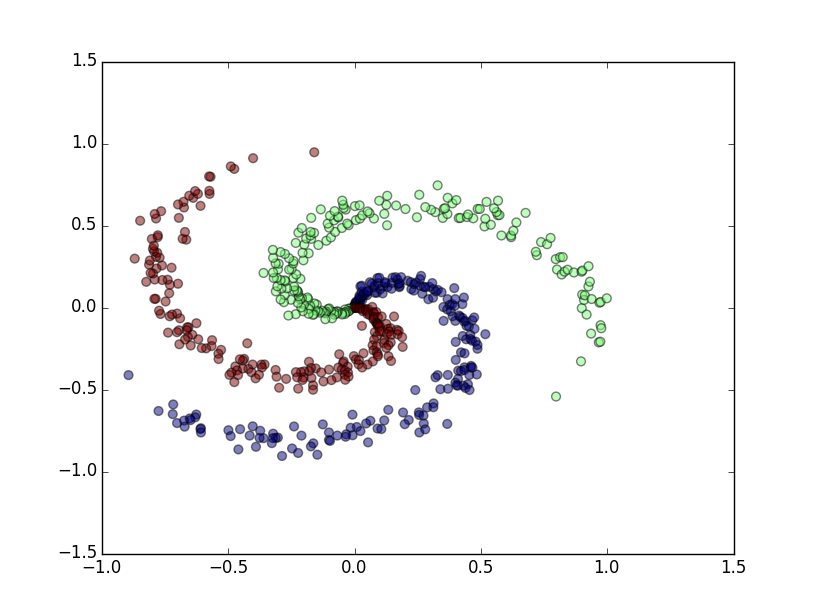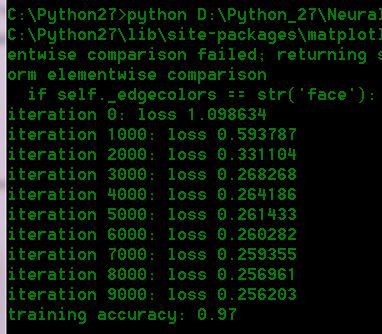Python: Neural Networks
这是用Python实现的Neural Networks, 基于Python 2.7.9, numpy, matplotlib。
代码来源于斯坦福大学的课程: http://cs231n.github.io/neural-networks-case-study/
基本是照搬过来,通过这个程序有助于了解python语法,以及Neural Networks 的原理。
import numpy as np
import matplotlib.pyplot as plt
N = 200 # number of points per class
D = 2 # dimensionality
K = 3 # number of classes
X = np.zeros((N*K,D)) # data matrix (each row = single example)
y = np.zeros(N*K, dtype='uint8') # class labels
for j in xrange(K):
ix = range(N*j,N*(j+1))
r = np.linspace(0.0,1,N) # radius
t = np.linspace(j*4,(j+1)*4,N) + np.random.randn(N)*0.2 # theta
X[ix] = np.c_[r*np.sin(t), r*np.cos(t)]
y[ix] = j
# print y
# lets visualize the data:
plt.scatter(X[:,0], X[:,1], s=40, c=y, alpha=0.5)
plt.show()
# Train a Linear Classifier
# initialize parameters randomly
h = 20 # size of hidden layer
W = 0.01 * np.random.randn(D,h)
b = np.zeros((1,h))
W2 = 0.01 * np.random.randn(h,K)
b2 = np.zeros((1,K))
# define some hyperparameters
step_size = 1e-0
reg = 1e-3 # regularization strength
# gradient descent loop
num_examples = X.shape[0]
for i in xrange(1):
# evaluate class scores, [N x K]
hidden_layer = np.maximum(0, np.dot(X, W) + b) # note, ReLU activation
# print np.size(hidden_layer,1)
scores = np.dot(hidden_layer, W2) + b2
# compute the class probabilities
exp_scores = np.exp(scores)
probs = exp_scores / np.sum(exp_scores, axis=1, keepdims=True) # [N x K]
# compute the loss: average cross-entropy loss and regularization
corect_logprobs = -np.log(probs[range(num_examples),y])
data_loss = np.sum(corect_logprobs)/num_examples
reg_loss = 0.5*reg*np.sum(W*W) + 0.5*reg*np.sum(W2*W2)
loss = data_loss + reg_loss
if i % 1000 == 0:
print "iteration %d: loss %f" % (i, loss)
# compute the gradient on scores
dscores = probs
dscores[range(num_examples),y] -= 1
dscores /= num_examples
# backpropate the gradient to the parameters
# first backprop into parameters W2 and b2
dW2 = np.dot(hidden_layer.T, dscores)
db2 = np.sum(dscores, axis=0, keepdims=True)
# next backprop into hidden layer
dhidden = np.dot(dscores, W2.T)
# backprop the ReLU non-linearity
dhidden[hidden_layer <= 0] = 0
# finally into W,b
dW = np.dot(X.T, dhidden)
db = np.sum(dhidden, axis=0, keepdims=True)
# add regularization gradient contribution
dW2 += reg * W2
dW += reg * W
# perform a parameter update
W += -step_size * dW
b += -step_size * db
W2 += -step_size * dW2
b2 += -step_size * db2
# evaluate training set accuracy
hidden_layer = np.maximum(0, np.dot(X, W) + b)
scores = np.dot(hidden_layer, W2) + b2
predicted_class = np.argmax(scores, axis=1)
print 'training accuracy: %.2f' % (np.mean(predicted_class == y))
随机生成的数据
运行结果
Python: Neural Networks的更多相关文章
- 【转】Artificial Neurons and Single-Layer Neural Networks
原文:written by Sebastian Raschka on March 14, 2015 中文版译文:伯乐在线 - atmanic 翻译,toolate 校稿 This article of ...
- tensorfolw配置过程中遇到的一些问题及其解决过程的记录(配置SqueezeDet: Unified, Small, Low Power Fully Convolutional Neural Networks for Real-Time Object Detection for Autonomous Driving)
今天看到一篇关于检测的论文<SqueezeDet: Unified, Small, Low Power Fully Convolutional Neural Networks for Real- ...
- 卷积神经网络CNN(Convolutional Neural Networks)没有原理只有实现
零.说明: 本文的所有代码均可在 DML 找到,欢迎点星星. 注.CNN的这份代码非常慢,基本上没有实际使用的可能,所以我只是发出来,代表我还是实践过而已 一.引入: CNN这个模型实在是有些年份了, ...
- 循环神经网络(RNN, Recurrent Neural Networks)介绍(转载)
循环神经网络(RNN, Recurrent Neural Networks)介绍 这篇文章很多内容是参考:http://www.wildml.com/2015/09/recurrent-neur ...
- Training Deep Neural Networks
http://handong1587.github.io/deep_learning/2015/10/09/training-dnn.html //转载于 Training Deep Neural ...
- Hacker's guide to Neural Networks
Hacker's guide to Neural Networks Hi there, I'm a CS PhD student at Stanford. I've worked on Deep Le ...
- 深度学习笔记(三 )Constitutional Neural Networks
一. 预备知识 包括 Linear Regression, Logistic Regression和 Multi-Layer Neural Network.参考 http://ufldl.stanfo ...
- 提高神经网络的学习方式Improving the way neural networks learn
When a golf player is first learning to play golf, they usually spend most of their time developing ...
- Introduction to Deep Neural Networks
Introduction to Deep Neural Networks Neural networks are a set of algorithms, modeled loosely after ...
随机推荐
- SpringBoot学习之启动方式
1.通过@SpringBootAppliction注解类启动 启动方法:找到注解类->鼠标右键->run as-> java application. 2 通过maven启动Spri ...
- HDOJ Oulipo 1686【KMP】
Oulipo Time Limit: 3000/1000 MS (Java/Others) Memory Limit: 32768/32768 K (Java/Others) Total Sub ...
- git分支处理
查看分支:git branch 创建分支:git branch <name> 切换分支:git checkout <name> 创建+切换分支:git checkout -b ...
- c# .net 关于接口实现方式:隐式实现/显式实现!
以前在用到接口时,从来没注意到接口分为隐式实现与显示实现.昨天在浏览博客时看到相关内容,现在根据自己的理解记录一下,方便日后碰到的时候温习温习. 通俗的来讲,“显示接口实现”就是使用接口名称作为方法 ...
- Window下安装Gradle并在IDEA中配置
真是作死啊,Maven都只是用得半瓢水,还来搞Gradle,小心撩得一身骚啊. 下载Gradle 下载页面为:https://gradle.org/releases/ Gradle 4.1的下载地址: ...
- erlang的timer定时器浅析
timer作为其计时器: erlang的计时器timer是通过一个唯一的timer进程实现的,该进程是一个gen_server,用户通过timer:send_after和timer:apply_aft ...
- Java8中 Date和LocalDateTime的相互转换
一.在Java 8中将Date转换为LocalDateTime 方法1: 将Date转换为LocalDatetime,我们可以使用以下方法: 1.从日期获取ZonedDateTime并使用其方法toL ...
- MySQL CREATE TRIGGER (1)
CREATE TRIGGER语法 CREATE TRIGGER trigger_name trigger_time trigger_event ON tbl_name FOR EACH ROW ...
- 关于 Delphi 中流的使用(7) 压缩与解压缩(TCompressionStream、TDecompressionStream)
unit Unit1; interface uses Windows, Messages, SysUtils, Variants, Classes, Graphics, Controls, For ...
- Java泛型【转】
一. 泛型概念的提出(为什么需要泛型)? 首先,我们看下下面这段简短的代码: public class GenericTest { public static void main(String[] a ...


